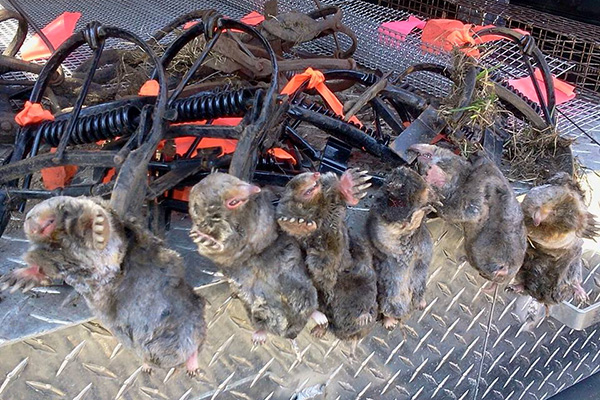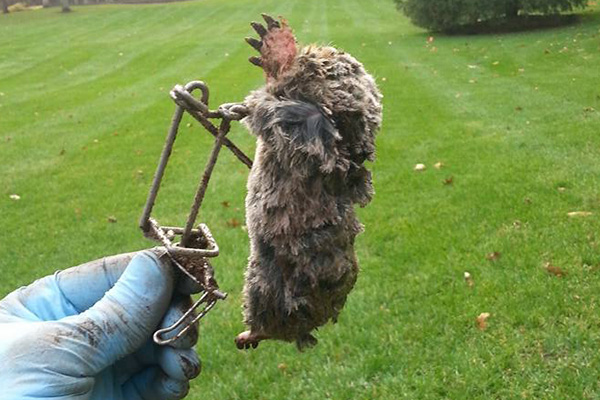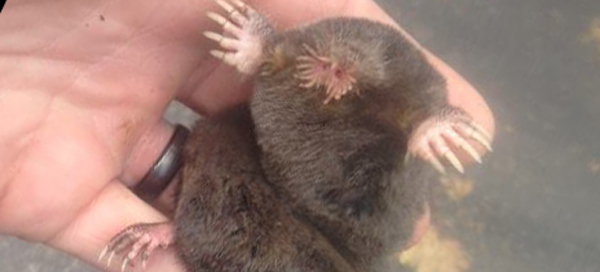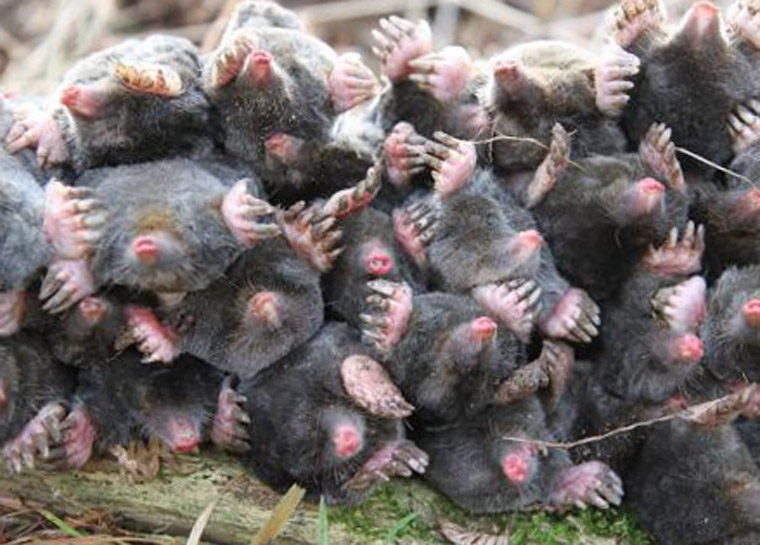- info@wildlife-removal.com
Call us for help in your town
Wildlife Removal Education
How to Get Rid of Moles in Yard
Need mole removal in your hometown? We service over 500 USA locations! Click here to hire us in your town and check prices - updated for year 2020.
If you have a mole problem on your property, then you are probably well aware that these beasts have to go. They simply are too much of a nuisance to ignore. They dig tunnels everywhere that cause a serious threat to yourself, your children, pets and livestock. One wrong step and a serious injury can occur. Read more about Mole biology.
There is also the problem of them destroying the garden or crops you have. The moles may see these foods as just as tasty to them as they are to you. This means you may find the mole enjoying a tasty salad of your garden vegetables instead of you.
Most people don't like the raised tunnels in the lawn or the mole hills. If you have a problem with a mole here are some solutions to the problem that may help you to rid yourself of these horrible animals.

The first place to begin is to make the entranceways no longer a viable option to get out of the tunnels. You can create a mixture of castor oil, hot water and dish soap that can help do the trick. Moles hate castor oil, so simply close up the holes and then pour the mixture over the dirt you used to close the hole. The mole will not like that hole area and will be forced to find another exit point. If you can keep moving the mole further away from your home you may force it far enough away.
It is a good idea to keep returning to add the mixture to the newly closed hole on a daily basis for a week. Also close any new holes and add the mixture to known foraging areas like gardens and garbage cans.
A big dog can be a great deterrent to a mole. Not only do dogs see these animals as something to go and annoy if not outright attack, but the dog will usually make a lot of noise when one appears. The barking will often scare away the mole. Be careful with this option however. Moles have very sharp front paws, and the last thing you want to happen is for your dog to get cut. Let it scare the mole but keep your dog at a bit of a distance.
Traps are one of the most common means to get rid of moles. You can use hollow traps to actually coral the mole where you can then take it and let it go somewhere else. This is for those who wish to be more humane in their treatment of the mole, but these traps don't really work, to be honest. You probably have to kill the mole. It is understandable if some simply want to get rid of the mole once and for all.

The two most commonly used traps to aid in this are the scissor trap and the harpoon trap. The scissor trap works quite simply. Placed at the entrance to the whole, the mole walks through the trap, setting off the mechanism. The trap then closes on it, and a spike lodges into the mole. The spike keeps the mole inside the trap. The scissor lock continually closes on the mole suffocating it until it finally dies.
The harpoon is a bit quicker acting. You simply take the legs of this trap and push them into the ground above a mole tunnel, the opening or a place where a tunnel will likely appear. As the mole hits the leg the harpoon mechanism shoots into the ground where it kills the mole quickly and with extreme prejudice. Once the creature is dead you simply leave it in its hole to be its grave.
There are also a few poison options you can use. The most effective of this is to leave a poison at the entrance of the tunnels that the mole can walk through. As it does so it gets the poison on its paws and belly. This is absorbed into the skin or is ingested during bathing and the mole becomes poisoned and dies. This can be very effective.
Some have chosen to poison the tunnel system with gas, but this can be quite dangerous. The mole may not be the only creature that is poisoned, as the ground will absorb these gaseous compounds and you could effectively kill most of the plants and wildlife around the tunnel area. Also your children or pets may breathe that in and get sick as well. That will not do.
There are also commercial products that you can buy that are fairly good as repellants. They should be placed that the entrances of tunnels and near known areas where the animals well forage for food. It makes no sense to put this around your property like a perimeter because the mole will just dig right under and get into your property anyway. You have to employ this in places where it can directly affect the mole.
You might also want prevention tips: How to keep moles away
. For more information, go to may main mole removal page.
Ways to Get Rid of Moles
Moles are tireless workers and they dig their tunnels all through the year. Here, they search for and store up their food. Their numerous mole hills and mounds can be utterly undesirable, especially when built on your neatly cultivated garden or nicely mown lawn. Whichever one it is, the owner of the garden or lawn being disfigured cannot wait to get rid of these moles. Luckily, there are many effective ways to get rid of moles and you just need to select the one that suits you best. Read the guide How Can Moles Damage Your Lawn?

Habitat modification and Exclusion
Underground fencing - An underground fence is a permanent, though maybe expensive way to get rid of your moles. They are excluded or prevented from entering your property via fences that extend below the ground level by about 2 feet and reach about half a foot above the ground. The fence must go below the ground sufficiently so that moles with their great digging ability cannot successfully dig below it and enter into the garden. Galvanized aluminium sheathing or stainless steel are the most commonly used materials for these underground fences.
Gravel pit - Another way to go about keeping moles from digging under your fence to access the garden is to dig a pit around the fence or garden and fill it up with gravel. Although moles can dig very well, they cannot dig through gravel as it is too hard for their claws. The gravel filling should be at least one foot deep so the moles can’t get beneath it to dig.
Trapping
You can use either of live traps and lethal traps to get rid of moles on your property. Traps are efficient at getting rid of the furry rodent when applied and positioned correctly.
Live traps
These do not kill the moles, but only catch them and allows for the owner to release or kill them later. Live traps are not as common and functional as lethal traps where moles are concerned. Depending on the specific type bought, the trap is set over the mole's active tunnel and will trap the mole once it crawls across it.
Another type of live trap comes in a bucket shape, and is usually concealed with debris. This trap is designed to shut against the mole as soon as the trap covering is triggered when the mole enters it.
Lethal traps
Lethal traps are designed to trap and kill moles, and they have proven to be more effective in eradicating moles than the live traps.
The barrel trap is a cylinder-like lethal trap, which when inserted into the mole's tunnel is triggered by the movement of mole around it. A strong loop then fastens itself around the mole and the mole will be killed as a result.
With a pair of scissor-like blades, the scissors trap kills moles by bringing its blades together and crushing a mole as soon as it gets in between them. This trap is usually placed in a small hole dug in the middle of active mole tunnels. An example of the scissor trap is Out O' sight mole trap.
The spear trap or harpoon trap comes with a sharp spear that pierces through a mole once it is caught. The trap is set at a spot above the tunnel, and whenever a mole tries to pass through this spot, the trigger gets pulled and the spear pierces the mole, killing it instantly.
Mole Repellents
Homemade repellents like Castor oil mixed with dish soap are capable of getting rid of moles when applied to the soil. This odorous mixture gives a repelling smell that drives moles away.
Natural repellent plants like mole plants, marigold, alliums, fritillaries, daffodils and castor beans can be cultivated in a garden frequented by moles or harbouring moles. Just like homemade repellents, these plants have a characteristic scent that drives moles away from wherever they are planted.
There are also the store bought repellents, such as smoker and ultrasonic sound emitters. Ultrasonic sound emitters produce sound and vibration capable of scaring moles away. The smoker, on the other hand, emits smoke that the moles find irritating and consequently move away from.
Poison
There is a variety of poisons that can be used to kill moles, each working in its own way. Some of them are Warfarin, Bromethalin, and fumigants. It is common for mole poisons to be shaped like worms in order to attract the animal with food bait. Care must be taken when applying any of these poisons because they do not pose a problem to moles alone, but also to humans and the environment. Residue of poisons can affect soil fertility and cause skin problems for humans if contacted. In extreme cases, some are even capable of killing children and pets.
Ways to Remove Moles
Let’s get the important information out the way nice and early — you will need to do your research when it comes to removing moles from your property. Let’s say that you live in Washington, D.C., for example. You’re not permitted to kill moles there, so your only option would be to drive them away from your property and then add modifications to stop them from coming back, or to attempt to live trap them and relocate them somewhere else. Sadly, you will find that there are laws surrounding the release of these wild critters too, giving you more information that you will need to look up before you take anti-mole action.

Other places across the USA will permit you to kill moles in order to get them off your land, but again, you will only be able to use specific methods. Snap traps or body grip traps for moles are illegal in Washington State. They’re inhumane and don’t usually do the job well, and the banning of them has proven to be a good thing, forcing trap manufacturers to make better, more humane and safe methods of kill trapping.
Live cage trapping is virtually impossible with moles, kicking that option out of the game. They just don’t seem to want to go in the trap and, if you don’t seal up the tunnel systems in time alongside taking preventative measures to stop the mole from coming back, you will still be faced with a mole problem sooner or later. They can travel for vast distances mostly undetected, especially underground. If you attempt to live-cage-trap a mole, be prepared for a lengthy wait, a lot of disappointment, and more moving around of traps than you would be willing to put up with.
That leaves you with a couple of other options. You could use repellents, which rarely work for ANY wildlife species, let alone moles. Castor oil is thought of as a mole repellent, but it is actually toxic to the animal and could kill it. If you're in Washington, D.C., you're in trouble. Even if you're not, you'll still be in trouble, but for different reasons. A mole that has died underground will stay underground. It will decompose down there. Maggots, flies, all sorts of other nasties will join the party. The smell will start to kick up and, although you might not be able to smell it for some time, other scavengers and opportunistic feeders will be able to. If you have foxes, coyotes, or raccoons in the area, there's a good chance that they will come and check it out. They'll try to dig it up and, if they succeed, you'll probably be left with one hell of a mess in the morning. Even if you don’t get a nuisance wildlife visitor to the secret underground grave, your pet will find it. Your dog loves to dig and roll around in the mud, right? Perhaps it's time to investigate why he keeps paying particular attention to that one spot over in the corner of your garden ... ?
For the same reasons, you shouldn’t attempt to kill moles with mole poison, rodent poison, or any other weird and wonderful mixture of toxic ingredients that you may have come across on the internet. Domesticated pets could get hold of the toxic compounds, as could other animals. Not only that, but secondary poisoning is a very big problem. If you were to use poison to kill a mole, and then another scavenger, such as a fox, finds that mole, it’ll probably eat it. The mole still has toxic in the body and that will be transferred to the fox via consumption. The fox will then suffer from the effects of being poisoned, although to a lesser extent than the mole. The same thing can happen if you replace the fox with a dog, cat, or any other animal. If the mole has been poisoned, secondary poisoning can easily occur.
Getting rid of moles can be a very troublesome task, especially if you are not clued up. It is possible to do the job yourself, without employing a professional, but you will need to be prepared for quite the battle. It’s remarkably more difficult to get rid of nuisance wildlife that live underground, especially when they’re as discreet and clever as the mole.
Go back to the Mole Removal page, or learn tips to do it yourself with my How to Get Rid of Moles guide.


















